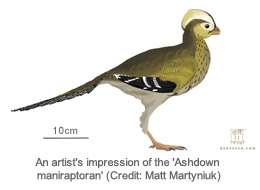(PhysOrg.com) -- Paleontologists digging in the south of England have unearthed what might be the smallest dinosaur ever discovered; at just a foot long and weighing only a couple hundred grams, the Ashdown maniraptoran, was apparently an omnivore, at least partially feathered and walked on two legs. In a paper published on Cretaceous Research, colleagues and coauthors Darren Naish and Steven Sweetman describe the remains as the posterior cervical vertebra of a small dinosaur found in the Pevensey Pit at Ashdown Brickworks, in East Sussex.
Because modern birds are technically descendants of dinosaurs; ones that survived the cataclysmic event that killed off most forms of life on Earth some 65 million years ago, this new find will have to exist with a footnote, as there are clearly birds around today that are smaller; also there is the Anchiornis found in China, whose size is still being debated.
The researchers estimate the full length of the Ashdown maniraptoran was 16-40 cm (derived from a centrum length of 7.1 mm) or about the size of a loaf of bread. They believe also, based on discovered bones of other similar dinosaurs that this one likely had a short tail, long neck and legs and forelimbs with claws, and probably sported feathers as well; likely making it closely related to birds. They also believe it probably weighed close to 200 grams, or about as much as three or four modern chicken eggs.
Dinosaurs are loosely defined as a group of vertebrate animals that roamed the earth from about 230 million years ago, till their decimation, some 65 million years ago. The newly discovered Ashdown maniraptoran is believed to have come from the Lower Cretaceous period, making it some 100 to 145 million years old. This new find provides more evidence that dinosaurs from this period were similar to those in the rest of Europe and even in North America, as it’s believed there were land bridges in existence during that time.
The author’s as well as many others in the field are hopeful more sample bones from Ashdown maniraptoran will be discovered, particularly a head, as that would give more clues as to what the small dinosaur ate and would of course give a better view of what it actually looked like. If that happens, a new scientific name will have to be chosen for it; one likely taking into account its diminutive nature.
More information: A tiny maniraptoran dinosaur in the Lower Cretaceous Hastings Group: Evidence from a new vertebrate-bearing locality in south-east England, Cretaceous Research, Volume 32, Issue 4, August 2011, Pages 464-471. doi:10.1016/j.cretres.2011.03.001
Abstract
In contrast to the Barremian Wessex Formation on the Isle of Wight, the remains of small theropods are rare in the Berriasian–Valanginian Hastings Group of the English mainland. Both units are part of the dinosaur-rich Wealden Supergroup (Berriasian–Aptian) of southern Britain. Here we report the cervical vertebra of a small dinosaur from the Pevensey Pit at Ashdown Brickworks, a site located northwest of Bexhill, East Sussex. The pit yields a rich assemblage of vertebrate fossils from the Valanginian Wadhurst Clay Formation of the Hastings Group. The new specimen, a near-complete but water-worn posterior cervical vertebra, is tiny (total centrum length = 7.1 mm) but evidently from an adult theropod. Its large hypapophysis, X-shaped neural arch and amphicoelous centrum suggest referral to Maniraptora, and the subparallel anterior and posterior articular surfaces imply that it does not belong to a deinonychosaur. The X-shaped neural arch recalls a similar condition seen in oviraptorosaurs while the high neural canal/articular surface ratio (0.70) is bird-like. The specimen is significant in representing the first maniraptoran to be reported from the Hastings Group but is otherwise indeterminate. By comparing the specimen to better known maniraptorans and estimating the proportions of the animal to which it belongs, we suggest that the total skeletal length of this maniraptoran was somewhere between 16 and 40 cm. It may therefore have been among the smallest of known Mesozoic dinosaurs.
© 2010 PhysOrg.com

.jpg)


















